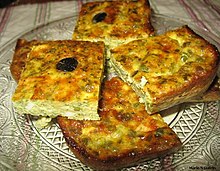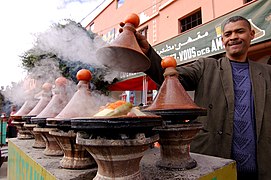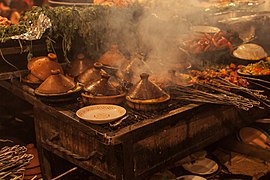Tajine
 A vegetable tajine dish as served in a London restaurant | |
| Alternative names | Tagine |
|---|---|
| Type | Steworcasserole |
| Region or state | Maghreb |
| Associatedcuisine | |
Atajineortagine(Arabic:طاجين) is aNorth Africandish, named after theearthenwarepot in which it is cooked.[1][2]It is also calledmaraqormarqa.
Etymology
[edit]TheArabicطجين(ṭažin) is derived fromAncient Greekτάγηνον(tágēnon) 'frying-pan, saucepan'.[3][4]
Origin
[edit]According to Rebecca Jones, in the 1990s, the late Dr Vivien Swan identified pottery from various sites on Scotland'sAntonine Wall,built by theNumidiangovernor of Roman Britain,Quintus Lollius Urbicus,of a North African style, one being acasseroledish that may have been a precursor to the modern tajine.[5][6]Fragments of tajines have also been identified amongNumidianceramics in modern-dayTunisia.[7]
According to some sources, the history of tagine dates back to the time ofHarun al-Rashid,the fifth Abbasid Caliph.[8][9][10]The concept of cooking in a tajine appears in the famousOne Thousand and One Nights,an Arabic-language story collection from the 9th century.[10]
Today, the cooking pot and its traditional broth are primarily prepared in the Middle East and North Africa. There are different ways to prepare the tajine. In the original qidra style,saman(clarified butter) is used to lubricate the surface and a puree of chopped onion is added for flavour and aroma. Formuqawlli-style cooking, the ingredients are placed inolive oilto enrich the flavours.
According to the historian of Jewish food Gil Marks, the unique two-piece cooking vessel made from red clay called tajine originates fromMorocco(Anti-AtlasMountains).[11]
Étienne Villot recounts in his bookCustoms and Institutions of the Indigenous People of Algeriain 1888:
All indigenous women know how to make pottery, from humble cups to the immense kolla of theKabyle Algerians.Clay pottery is very common in Algeria. Various colors, usually red, yellow, and black, are applied to the pottery pieces shaped by the women. These colors are fixed onto the clay using a varnish composed of pine resin and a little bit of olive oil. Kabyle women have great skill in these types of work.[12]
There are many descriptions of how to prepare a tajine from Arab scholars. A famous description is the one fromibn al-Adim(1192–1262):
Boil the meat and fry with fresh coriander, onions and hot spices and a little garlic. Then pick out the fennel hearts and cut in half. Put over the meat. Put back some of the broth on it along with sheep's tail. Boil until cooked and the broth has been absorbed. Remove [from the heat].
— Ibn al-Adim,Kitab Al Wuslah il Al-Habib fi wasf al tayyibat wa Al-Tib
Tajines have been in use for an extended period, persisting to the present day. In 1859, French explorer, geographer, archaeologist, librarian, and Maghreb expertOscar Mac Carthyrecounted encountering cooking tajines and pottery in the streets ofAlgeria.He described them as large hollow pots of various shapes.[13]Additionally, a Tunisian review from 1896 also references the presence of pottery and tajines in Tunisia.[14]

Pottery
[edit]The traditional tajinepottery,sometimes painted orglazed,consists of two parts: a circular base unit that is flat with low sides and a large cone- or dome-shaped cover that sits on the base during cooking. The cover is designed to return allcondensationto the bottom. That process can be improved by adding cold water into the specially designed well at the top of the lid.
Tajine is traditionally cooked over hot charcoal leaving an adequate space between the coals and the tajine pot to avoid having the temperature rise too quickly. Large bricks of charcoal are used, specifically for their ability to stay hot for hours. Other methods are to use a tajine in a slow oven or on a gas or electric stove top, on the lowest heat necessary to keep the stew simmering gently. Adiffuser,a circular utensil placed between the tajine and the flame, is used to evenly distribute the stove's heat. European manufacturers have created tajines with heavycast-ironbottoms that can be heated on a cooking stove to a high temperature, which permits the browning of meat and vegetables before cooking.
Tajine cooking may be replicated by using aslow cookeror similar item, but the result will be slightly different.[citation needed]Many ceramic tajines are decorative items as well as functional cooking vessels. Some tajines, however, are intended only to be used as decorative serving dishes.
Algerian and Moroccan tajine
[edit]
Algerian and Moroccan tajine dishes are slow-cooked stews, typically made with sliced meat, poultry or fish together with vegetables or fruit.[15][16][17]Spices, nuts, and dried fruits are also used. Common spices includeginger,cumin,turmeric,cinnamon,andsaffron.Paprikaandchiliare used in vegetable tajines. The sweet and sour combination is common in tajine dishes like lamb with prunes and spices. Tajines are generally served with bread. Because the domed or cone-shaped lid of the tajine pot traps steam and returns the condensed liquid to the pot, a minimal amount of water is needed to cook meats and vegetables. This method of cooking is important in areas where water supplies are limited or where public water is not yet available.[18]
Tunisian and Libyan tajine
[edit]
What Tunisians refer to as a "tajine" is very different from other forms of the dish.[19]Tunisiantajine is more like a Frenchquichewhile theLibyanis more similar to an Italianfrittataor aneggah.First, a simpleragoutis prepared, of meat cut into very small pieces, cooked with onions and spices, such as a blend of driedroseflowerbudsand ground cinnamon known asbaharator a robust combination of groundcorianderandcarawayseeds; this is calledtabil.[20]Then something starchy is added to thicken the juices. Common thickeners includecannellini beans,chickpeas,breadcrumbsor cubed potatoes. When the meat is tender, it is combined with the ingredients which have been chosen to be the dominant flavouring. Examples include freshparsley,driedmint,saffron,sun-dried tomatoes,cooked vegetables and stewed calves' brains. Next, the stew is enriched with cheese and eggs. Finally, this egg and stew are baked in a deep pie dish, either on the stove or in the oven until top and bottom are crisply cooked and the eggs are just set. When the tajine is ready, it is turned out onto a plate and sliced into squares, accompanied by wedges oflemon.Tunisian tajines can also be made with seafood or as a completely vegetarian dish.[citation needed]
In rural parts of Tunisia, home cooks place a shallow earthenware dish over olive-wood coals, fill it, cover it with a flat earthenware pan, and then pile hot coals on top. The resulting tajine is crusty on top and bottom, moist within and is infused with a subtle smoky fragrance.[citation needed]
Maghrebi Jewish tagine
[edit]Maghrebi Jewsalso eat and prepare tagine, owing to their historic presence in North Africa. Tagine is a very important dish inSephardi cuisine,and is commonly eaten and prepared byMoroccan Jews,Algerian Jews,Tunisian Jews,Libyan Jews,Djerban Jews,and also byFrench Jews,Jewish Americans,andIsraelis,due to the large population of Sephardim in those countries.[citation needed]
Tagine is a mainstay ofSephardic cuisine[21]commonly prepared forShabbatdinners in the Sephardi community, and served with couscous. Sephardim from different regions prepare different styles of tagine, for instance Moroccan Jews often prepare tagine with dried fruits, while Tunisian Jews often prepare a vegetable tagine containing potatoes, carrots, and zucchini cut into large dice. Tagine is also commonly prepared forJewish holidayssuch asRosh Hashanahand theYom Kippurbreak-fast.[22]
Gallery
[edit]-
Tajine potter
-
Tajine cooking
-
Electrical tajine
-
Stovetopcooking of tajine
-
Tajine with lamb, prunes and almonds
-
Algerian tajine with chicken, meatballs and olives
See also
[edit]- List of Middle Eastern dishes
- List of African dishes
- List of egg dishes
- Berber cuisine
- List of stews
- Rfissa
- List of cooking vessels
References
[edit]- ^"Nedroma (Oran)".Magasin pittoresque(in French). Paris: Jouvet & cie. 1859. p. 182.
- ^Uebersax, Mark A.; Siddiq, Muhammad, eds. (2012).Dry Beans and Pulses: Production, Processing and Nutrition.John Wiley & Sons. p. 516.ISBN978-1-118-44828-1.
- ^Albala, Ken (2011).Food Cultures of the World Encyclopedia, Volume 1.Greenwood. p. 234.ISBN978-0313376269.
The Arabic word ṭažin is derived from the Greek teganon, meaning "frying pan".
- ^τάγηνον,Henry George Liddell, Robert Scott,A Greek-English Lexicon,on Perseus
- ^Africans on the Antonine Wall? Rebecca Jones Historic Environment Scotland
- ^Jones, Rebecca H. (2021)."What Divides Us Also Connects Us: Roman Frontiers, World Heritage and Community".The Historic Environment: Policy & Practice.12(2): 120–145.doi:10.1080/17567505.2021.1916703.S2CID236625898.
- ^Ben Moussa, Moncef, Joan Ramon, Víctor Revilla Calvo, Joan (Sanmartí i Grego) Sanmartí, Maria Carme Belarte Franco, Chokri Touihri, Imed Ben Jarbania, and Sami Ben Tahar.Catalogue Du MobilierArchived2022-07-17 at theWayback Machine.2011. Consorci de Biblioteques Universitàries de Catalunya, Centre de Serveis Científics i Acadèmics de Catalunya.
- ^Roden, Claudia (2008-12-24).The New Book of Middle Eastern Food.Knopf Doubleday Publishing Group.ISBN9780307558565.
- ^"Tagine in heartwarming spoonfuls".english.alarabiya.net.Al Arabiya Newsdate=22 April 2011. 22 April 2011.Retrieved2017-10-14.
- ^abSnodgrass, Mary Ellen (2004-12-29).Encyclopedia of Kitchen History.Routledge.ISBN1135455716.
- ^Marks, Gil (2010-11-17).Encyclopedia of Jewish Food.HMH.ISBN978-0-544-18631-6.
- ^Villot, E. (1888).Moeurs, coutumes et institutions des indigènes de l'Algérie(in French). Jourdan.
- ^MACCARTHY, Oscar (1859).Notes et notices algériennes[Algerian notes and notices] (in French). Bastide. p. 37.
- ^Revue tunisienne(in French). 1896.
- ^Lucy M. Long (17 July 2015).Ethnic American Food Today: A Cultural Encyclopedia.Rowman & Littlefield Publishers. pp. 24–27.ISBN978-1-4422-2731-6.
- ^Sari Edelstein (2011).Food, Cuisine, and Cultural Competency for Culinary, Hospitality, and Nutrition Professionals.Jones & Bartlett Learning. p. 344.ISBN978-0-7637-5965-0.
- ^"The Art of Moroccan Cuisine".fescooking.com.10 October 2007.
- ^"How to Use a Moroccan Tagine: Origins, Culinary Uses, and 7 Tagine Recipe Ideas".Retrieved2 July2022.
- ^Paula Wolfert."Recipe for Tunisian Tajine".Retrieved2014-07-21.
- ^Nancy Harmon Jenkins."Divine Secrets of the Mahjoub Sisterhood".Archived fromthe originalon 2008-05-09.Retrieved2008-04-27.
- ^"Seven Sephardic Foods that won't make buzzfeed gag".The Forward.Retrieved18 October2019.
- ^"You're Doing it Wrong: Tagine".Slate. Archived fromthe originalon 18 October 2019.Retrieved18 October2019.
Further reading
[edit]- Connelly, Michael Alan (December 18, 2014)."20 Must-Try Street Foods Around the World".Fodor's.RetrievedJuly 24,2016.






